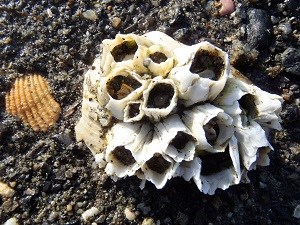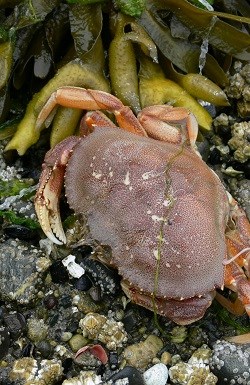
BarnaclesBarnacles (Balanus, Chthamalus) are ubiquitous marine animals that are found along shores throughout the world. They are crustaceans, and thus are related to crabs and shrimp. Though several species exist in Bartlett Cove, they aren’t easy to tell apart. Barnacles may dominate in the high intertidal or in some areas of low salinity where few other marine species can live. Some particularly hardy barnacles survived one 3-year experiment in which they were submerged in sea water for only one day every three months. There is also a local species which lives only on the skin of humpback whales. In the middle intertidal zone barnacles can get so crowded that they force each other into a tall, thin “pencilform” shape. Another local species found in deeper water can reach 8 inches in diameter and is probably the largest barnacle in the world. Barnacles feed on plankton in the water and, in turn, are eaten by a number of predators, including starfish, dogwinkles, and ribbon worms. To feed, it sweeps the water with its legs, called cirri, and pulls in food and fans out wastes. Barnacles can usually be observed feeding in tidepools or just below the water line. 
CrabsThere are a small number of pea crabs (Pinnixa) living commensally with other organisms in burrows or even inside the shells of some clams. However, the crab species of greatest interest to a visitor to Glacier Bay is likely to be the Dungeness crab (Cancer). It may be difficult to find Dungeness crabs except at the lowest tides, and even then they will usually be buried in the sand of mud. The greater number of these crabs in deeper water is attested to by the large number of molts found along the beach. A molt is an old discarded shell or exoskeleton. A mature crab will molt only once a year, but younger ones may molt as many as six times in one year. Male crabs can be distinguished from females by the size and shape of the abdomen or “tail” which is folded underneath. The abdomen of the male is long and thin, at least twice as long as it is wide. The female has a smaller and wider abdomen under with it carries its eggs. Only male crabs are permitted to be taken for commercial or private use, and they must be at least six and one half inches across the back. Crabs are predators. They feed on many kinds of animals buried in the sand—especially clams. A crab uses its large claw to capture and manipulate its prey and to chip open clams. Crabs in turn are eaten by octopuses, bottom fish such as halibut, and, of course, man. |
Last updated: March 16, 2018
